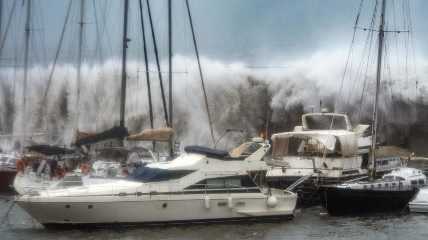
BAR HARBOR, Maine (AP) — No longer bearing the title of hurricane but almost as strong as one, Lee toppled trees, swamped boats and streets, and cut power to tens of thousands Saturday as it lashed a huge swath of New England and eastern Canada with high winds, rough surf and torrential rains.
The storm, now a post-tropical cyclone, was expected to make landfall near hurricane strength in Atlantic Canada on Saturday afternoon, then weaken as it moved farther into the region.
In Bar Harbor, the touristy gateway to Acadia National Park, officials closed a parking lot at a pier as high tide moved in and waves crashed against seawalls.
In the Canadian province of Nova Scotia, Lee flooded coastal roads and boats, knocked down power lines and trees, and took ferries out of service as it fanned anxiety in a region still reeling from wildfires and severe flooding this summer, said Pam Lovelace, a councilor in Halifax, the capital.
“People are exhausted. ... It’s so much in such a small time period,” Lovelace said. “From a mental health perspective, we’re asking people to check in on their neighbors.”
In the United States, a tropical storm warning was in effect for a 230-mile stretch from Portsmouth, New Hampshire, to the eastern end of Maine.
Storm surge of 1 to 3 feet was predicted for the Maine coast, and the U.S. hurricane center warned it would be accompanied by large and destructive waves. The storm could drop as much as 4 inches of rain on parts of Maine, Massachusetts, Nova Scotia and New Brunswick through Saturday night, with the potential for local flooding, forecasters said.
The storm skirted some of the most waterlogged areas of Massachusetts that experienced severe flash flooding days earlier, when fast water washed out roads, caused sinkholes, damaged homes and flooded vehicles.
But the entire region has experienced an especially wet summer — it ranked second in the number of rainy days in Portland, Maine — and Lee’s high winds toppled trees stressed by the rain-soaked ground in Maine, the nation’s most heavily wooded state.
The storm’s center was just off southern Nova Scotia — dozens of miles southeast of Eastport, Maine — with maximum sustained winds near 70 mph (110 kph), the U.S. National Hurricane Center said in its 2 p.m. EDT advisory. Hurricane strength is 74 mph (119 kph).
Hurricane-force winds extended outward as far as 140 miles (220 kilometers) from its center, with tropical-storm-force winds extending as far as 390 miles (630 kilometers) — enough to cover all of Maine and much of Maritime Canada.
The storm was so big that it caused power outages several hundred miles from its center. At midday Saturday, at least 10% of electricity customers in Maine lacked power, along with 25% of Nova Scotia and 8% of New Brunswick.
“At this point, the storm is resembling a nor’easter,” said Sarah Thunberg, a National Weather Service meteorologist, referring to the fall and winter storms that often plague the region and are so named because their winds blow from the northeast.
In typical tropical cyclones, Thunberg said, winds are concentrated around the eye. But Lee, a very large storm, has a wider wind field.
A tropical storm warning was in effect for much of New Brunswick and all of Nova Scotia and Prince Edward Island, along with a hurricane watch for parts of New Brunswick and Nova Scotia.
Nova Scotia’s largest airport, Halifax Stanfield International, had no incoming or outgoing flights scheduled Saturday.
Cruise ships found refuge at berths in Portland, while lobstermen in Bar Harbor and elsewhere pulled traps from the water and hauled boats inland.
Billy Bob Faulkingham, House Republican leader of the Maine Legislature, and another lobsterman survived after their boat overturned while hauling traps ahead of the storm Friday, officials said.
The boat’s emergency locator beacon alerted authorities, and the two clung to the hull until help arrived, said Winter Harbor Police Chief Danny Mitchell. The 42-foot boat sank.
“They’re very lucky to be alive,” he said.
Lee lashed the U.S. Virgin Islands, the Bahamas and Bermuda before turning northward, and heavy swells were causing life-threatening surf and rip currents in the U.S. and Canada, according to the hurricane center.
Forecasters urged residents to stay home: “Nothing good can come from checking out the big waves and how strong the wind truly is,” said Kyle Leavitt, director of the New Brunswick Emergency Management Organization.
But many ventured out anyway. Among them was Ren Renton on Maine’s Bailey Island, a slender spit jutting into the Gulf of Maine.
“The ocean is always dynamic no matter what storm you get,” she said. “It comes and goes and takes what it wants, but hopefully not too much.”
Lee shares some characteristics with 2012’s Superstorm Sandy. Both were once strong hurricanes that became post-tropical cyclones — cyclonic storms that have lost most of their tropical characteristics — before landfall. But Lee was not expected to be nearly as destructive as Sandy, which caused billions of dollars in damage and was blamed for dozens of deaths in New York and New Jersey.
Lee also isn’t anywhere near as severe as the remnants of Hurricane Fiona, which a year ago washed houses into the ocean, knocked out power to most of two provinces and swept a woman into the sea, said Canadian meteorologist Jill Maepea.
Destructive hurricanes are relatively rare so far north. The Great New England Hurricane of 1938 brought gusts as high as 186 mph (300 kph) and sustained winds of 121 mph (195 kph) at Massachusetts’ Blue Hill Observatory. But there have been no storms that powerful in recent years.




